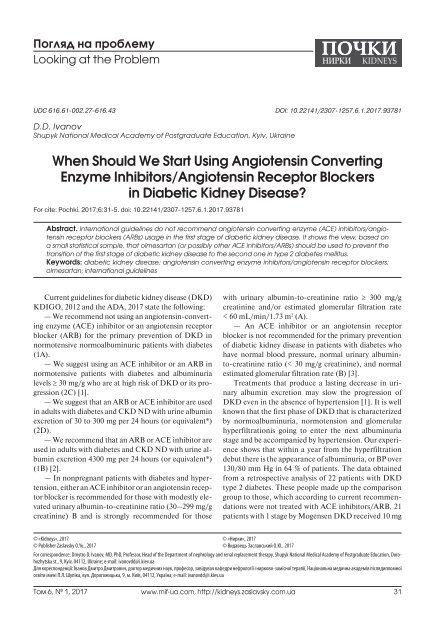Журнал "Почки" №1 (19) 2017
You also want an ePaper? Increase the reach of your titles
YUMPU automatically turns print PDFs into web optimized ePapers that Google loves.
Ïîãëÿä íà ïðîáëåìó<br />
Looking at the Problem<br />
UDC 616.61-002.27-616.43 DOI: 10.22141/2307-1257.6.1.<strong>2017</strong>.93781<br />
D.D. Ivanov<br />
Shupyk National Medical Academy of Postgraduate Education, Kyiv, Ukraine<br />
When Should We Start Using Angiotensin Converting<br />
Enzyme Inhibitors/Angiotensin Receptor Blockers<br />
in Diabetic Kidney Disease?<br />
For cite: Pochki. <strong>2017</strong>;6:31-5. doi: 10.22141/2307-1257.6.1.<strong>2017</strong>.93781<br />
Abstract. International guidelines do not recommend angiotensin converting enzyme (ACE) inhibitors/angiotensin<br />
receptor blockers (ARBs) usage in the first stage of diabetic kidney disease. It shows the view, based on<br />
a small statistical sample, that olmesartan (or possibly other ACE inhibitors/ARBs) should be used to prevent the<br />
transition of the first stage of diabetic kidney disease to the second one in type 2 diabetes mellitus.<br />
Keywords: diabetic kidney disease; angiotensin converting enzyme inhibitors/angiotensin receptor blockers;<br />
olmesartan; international guidelines<br />
Current guidelines for diabetic kidney disease (DKD)<br />
KDIGO, 2012 and the ADA, <strong>2017</strong> state the following:<br />
— We recommend not using an angiotensin-converting<br />
enzyme (ACE) inhibitor or an angiotensin receptor<br />
blocker (ARB) for the primary prevention of DKD in<br />
normotensive normoalbuminuric patients with diabetes<br />
(1A).<br />
— We suggest using an ACE inhibitor or an ARB in<br />
normotensive patients with diabetes and albuminuria<br />
levels 30 mg/g who are at high risk of DKD or its progression<br />
(2C) [1].<br />
— We suggest that an ARB or ACE inhibitor are used<br />
in adults with diabetes and CKD ND with urine albumin<br />
excretion of 30 to 300 mg per 24 hours (or equivalent*)<br />
(2D).<br />
— We recommend that an ARB or ACE inhibitor are<br />
used in adults with diabetes and CKD ND with urine albumin<br />
excretion 4300 mg per 24 hours (or equivalent*)<br />
(1B) [2].<br />
— In nonpregnant patients with diabetes and hypertension,<br />
either an ACE inhibitor or an angiotensin receptor<br />
blocker is recommended for those with modestly elevated<br />
urinary albumin-to-creatinine ratio (30–299 mg/g<br />
creatinine) B and is strongly recommended for those<br />
with urinary albumin-to-creatinine ratio 300 mg/g<br />
creatinine and/or estimated glomerular filtration rate<br />
< 60 mL/min/1.73 m 2 (A).<br />
— An ACE inhibitor or an angiotensin receptor<br />
blocker is not recommended for the primary prevention<br />
of diabetic kidney disease in patients with diabetes who<br />
have normal blood pressure, normal urinary albuminto-creatinine<br />
ratio (< 30 mg/g creatinine), and normal<br />
estimated glomerular filtration rate (B) [3].<br />
Treatments that produce a lasting decrease in urinary<br />
albumin excretion may slow the progression of<br />
DKD even in the absence of hypertension [1]. It is well<br />
known that the first phase of DKD that is characterized<br />
by normoalbuminuria, normotension and glomerular<br />
hyperfiltrationis going to enter the next albuminuria<br />
stage and be accompanied by hypertension. Our experience<br />
shows that within a year from the hyperfiltration<br />
debut there is the appearance of albuminuria, or BP over<br />
130/80 mm Hg in 64 % of patients. The data obtained<br />
from a retrospective analysis of 22 patients with DKD<br />
type 2 diabetes. These people made up the comparison<br />
group to those, which according to current recommendations<br />
were not trea ted with ACE inhibitors/ARB. 21<br />
patients with 1 stage by Mogensen DKD received 10 mg<br />
© «Kidneys», <strong>2017</strong> © «Нирки», <strong>2017</strong><br />
© Publisher Zaslavsky O.Yu., <strong>2017</strong> © Видавець Заславський О.Ю., <strong>2017</strong><br />
For correspondence: Dmytro D. Ivanov, MD, PhD, Professor, Head of the Department of nephrology and renal replacement therapy, Shupyk National Medical Academy of Postgraduate Education, Dorohozhytska<br />
st., 9, Kyiv, 04112, Ukraine; e-mail: ivanovdd@i.kiev.ua<br />
Для кореспонденції: Іванов Дмитро Дмитрович, доктор медичних наук, професор, завідувач кафедри нефрології і нирково-замісної терапії, Національна медична академія післядипломної<br />
освіти імені П.Л. Шупіка, вул. Дорогожицька, 9, м. Київ, 04112, Україна; e-mail: ivanovdd@i.kiev.ua<br />
Òîì 6, ¹ 1, <strong>2017</strong><br />
www.mif-ua.com, http://kidneys.zaslavsky.com.ua 31















